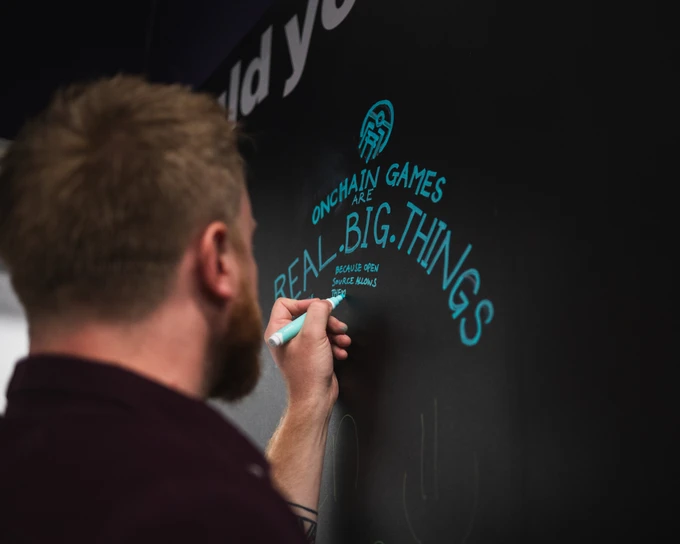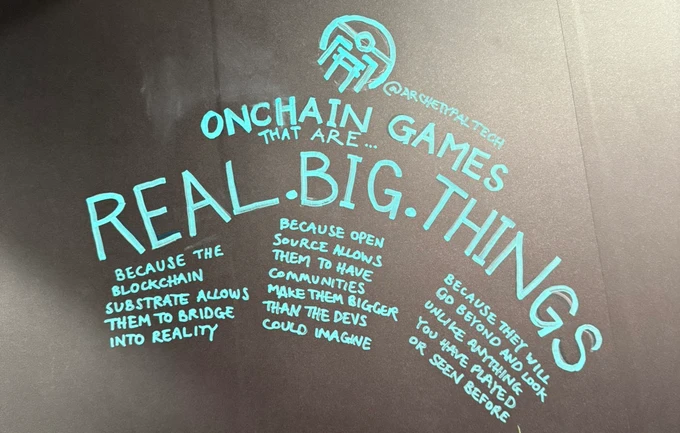#RealBigThings #Thesis #Bb #Thesis #XStatement #Narrative

We make REAL.BIG.THINGS “We explore the forefront of how creative communities collaborate”.
#REAL...because the blockchain allows games to bridge from the digital into reality.
#BIG...because the monetization of open source allows games to have communities that collaborate to make them bigger than the original devs could have imagined.
#THINGS ...Because these game will go beyond and look unlike anything you have played or seen before.

“REAL”
People want meaning. People need something real as their foothold. People play order to learn, explore, improve, and ultimately there is a desire for the play experience to be at least mappable to something else in their lives. (Players often suffer anxiety or guilt to do with the time sunk into a game, not because it was meaningless, but because its benefit is abstract or hard to identify). People want to enjoy play and connection, and have it persist. Have it go beyond the when the screen is turned off, have it rooted in the real.
The game’s stress must be able to be left in n the machine and walked away from (it’s only a game) - the games connection must persist, people must feel valued and feel progress after they have logged off.
It is ultimately unavoidable that ML / LLMs / agents will be in everything we do, whether just part of user generated content pipelines , or actively in the core engines of the experiences we make.
The rise of AI and LLMs and therefore the huge increase in synthetic data (enshitification) will mean a renewed gravitation toward “the real”
People crave meaning, and belonging, the current drive of AI in content is toward solipsism, we believe people will want to harness it towards collective creative and experiential goals, grounded in the “real” (which will have myriad layers of definition and at tikes be subjective but ultimately is about having an effect on them and a chosen community in some material or measureable way)
“BIG”
AI and crypto rails will enable larger scale, collective work output, coordination, and grass roots/ bottom up / user generated projects that would never have been possible before.
In order to be “big”, we need to bring together a stack not just for creation, but also for distribution, and for targeted / specific / collective capital allocation
This project itself has to be big (made of several smaller projects) and be an exercise in constantly dogfooding itself, and proving itself out.
It will also naturally be an excercise in making use of the composable and “money legos” practices, of slotting in the best of other projects or leveraging their open source nature.
“THINGS”
This scale will come in the form of things we don’t traditionally classify as games, or that go beyond, are many games bundled up l, or are games-between-games. They are ways in which narratives and goals transcend and crossover between media and activity or platform, and they require open source to be able to do that and resist the traditional contraction from moat to walled garden seen in previous tech eras.
In times before, elements of this would be called “meta-games” or ARGs (Alternative Reality Games) but this added layer of the real, and the manner in which crypto blurs boundaries and creates downstream and third order effect, mean that we are at the beginning of an era in net new collective experiences that go beyond games, and for now are so encompassing that they can only be known as “things”.
Real Big Things
Real big things go “beyond money”, as a culmination of these three principles it is possible to unlock human and technological potential via the things we enjoy doing, as the vast majority of populations stop being motivated by money alone once their base maslovian needs are met. We can take the financial output and incentives of most crypto experiences and help communities take them into reaching meaningful goals in the real. The blurriness of “things” and the safety of being couched initially games and simulations, as play environments in which people have always learned how to eventually best project into the real (see Huizinga et al), gives people the freedoms to dream big and experiment, building towards greater and bigger impacts in the real. These are the foundations of pedagogy, skill acquisition and infact game design.
Why have a thesis
What is a thesis?
3-7 things that you are betting on being true in order for a project to succeed.
This is useful for "failing fast", or actually - “figuring out if you are on a failing path, and correcting quickly” and then working out how and when to adjust or pivot
One of the ways to assess velociy and direction before PMF is is to track whether your confidence in any of those theses pillars are consistently going up or down, if one is going down consistently over time, then that is a time when it is a strong argument to think about pivoting.
Effectively, to fail fast and correct quickly, a strong and concise these is helpful to track confidence in direction
Having a crisp set of theses is helpful in a number of ways. It's helpful on pitch, marketing, and messaging, but also helpful on your own ability to analyse your business.
We believe good theses are not just a collection aloof and esoteric buzz words, they are drivers of businesses.
The Longform Thinking
The thesis of "digipiazzas", REAL BIG THINGS, "realfantasie", and large lore models. Making, empowering, and enabling ideas bigger than the originators themselves, games that require a village around them to be fleshed out and supported, games that originators and developers only start and creators and communities finish, games that teach people to hack, games that people use to explore the controlling forces around them, games that help people learn to love themselves and those around them, games that create new economic systems.
We are building the fist Large Lore Model of "things". We are indexing the interconnectedness between ideas and IP and allowing communities to fill the gaps. Taking the AW thesis and applying it to people who do "things" with passion, we are starting with video games and UGC as it is a space that already understands this.
Bridgebuilder is a way to search canon and IP and create product by following links and understanding the heatmaps of what is interrelated and popular, and allowing users to fill in that stuff, add glue, weave fabric. We are building the digital Alexandria, the library of world knowledge, it will start in digital simulations and games, and seep out into the real world, into everything.
The Archetypal thesis centers around making cultural connections... around making BIG THINGS, games and meta games that have real world impact, whether culturally, educationally, or even physically, and enabling communities to build on them together.
This stems from our studio's background making commercial video games in both the entertainment and educational sectors, and spending a decade on how powerful play is for thinking and learning in not just in its traditional understanding, and for all shapes, sizes, and ages of people.
Fully on chain games provide a new set of opportunities, games and communities that have inbuilt collaboration and payment rails, infinite monetisation (or lack thereof) and therefore collaboration configuration opportunities (making new and niche experiences possible and profitable in different ways), games that have maximal extensibility for UGC and mods, and games that can be testing grounds for other future technologies (see the Pace Layering framework). (Nico Vereeke’s Bitkraft article)[https://www.bitkraft.vc/insights/fully-onchain-games-thesis/] sums these opportunities up well.

We live in world that is starting to show signs of how games can reach into it. Games and the emerging scaffolding around them have the potential to not just model and simulate, but prove and even have agency over important factors deeper in our world’s layers.
To truly achieve this though games and ideas, their creator communities need new collaborative frameworks and ways of coordinating. This is why we have developed Bridgebuilder, a medium for ideas, games and their worlds to be collaboratively built upon, commissioned, permissioned, remixed and reinvented.
There is of course no point in building a platform if you can’t prove it is useful, and so our approach it to build out content that helps shapes the usecase in parallel. Leading the pack, onboarding fellow builders artists and thinkers and supporting them on their journeys.
Where are we currently in maturation of these potentials for Games?
The short answer is currently the market for fully onchain games is significantly underdeveloped and needs to be more fully established, and part of this comes down to blurring the line between onchain and offchain experiences as we know them.
- we need make [digital market squares] or #digipiazzas - digital places people hang out and business and culture develop around that are open and shaped by users, (town squares and distribution pipelines for markets to form around)
- we need to combine the real with our virtual experiences, a [realfantasie] if you will, so that the payment rails and affordances of onchain games can have meaning in people’s real lives too (not just high stakes or serious financial consequences- as are the knock on effects of only leaning if into hyper financialisation and no other cultural effects)
FOCG's are in an equivalent state to Apps on the first iPhone before the AppStore launched, there was no distribution method and so no known players to reach. We need to create town squares and places for players to congregate. Steam has 132 million monthly active users, we are here to become a part of how onchain games create town squares for markets to form around, we need to aim for hundreds of millions of MAUs (there are currently on 550 million wallets across all of crypto, let alone active) and more.
As an aside, and to give a sense of where this looks from a game developer's perspective, we love that we are at a point when academic thinking is crossing paths with open/accessible tooling coming online, and an artistic creative community coalescing. It reminds us of the Jesper Juul, Xna framework/Unity, Indie wave, and Xbox Live Arcade / Steam Greenlight that made a golden era for artful, diverse, and profitable indie games back in 2008-2011, that took the whole scene commercial. Lots of thinking and building still to be done here, (not least how to create town squares and distribution pipelines for markets to form around) but we are in a great moment and setting ourselves up to be at the forefront of it.
NEXT : What is Archetypal Tech